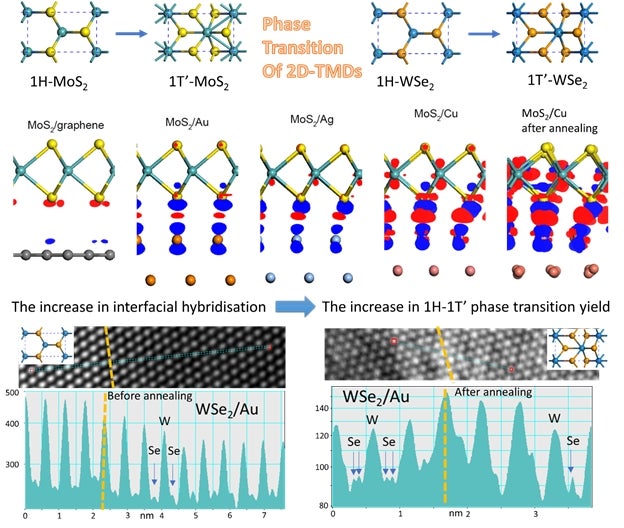Phase transition dynamics in two-dimensional (2D) materials
Andrew WEE (Group Leaders, Physics) February 12, 2019NUS scientists have discovered the mechanism involved when transition metal dichalcogenides on metallic substrates transform from the semiconducting 1H-phase to the quasi-metallic 1T’-phase.
Two-dimensional transition metal dichalcogenides (2D-TMDs) such as monolayer molybdenum disulphide (MoS2) are atomically thin semiconductors in which a layer of transition metal atom is sandwiched between two layers of chalcogen atoms, in the form MX2. They can exist in both a semiconducting 1H-phase and a quasi-metallic 1T’-phase, with each having a different crystal structure. The 1T’-phase is particularly interesting as theoretical predictions show that it has potential to be used in less conventional applications, such as super capacitor electrodes and hydrogen evolution reaction catalysts. However, the quantity of 1T’-phase 2D-TMDs that can be obtained by converting them from the 1H-phase through a phase transition process is low. This potentially limits the use of such novel materials for a wide range of applications.
A research team led by Prof Andrew WEE from the Department of Physics, NUS has discovered that, while different 2D-TMD materials have their own intrinsic energy barriers when transiting from the 1H to the 1T’ structural phase, the use of a metallic substrate with higher chemical reactivity can significantly increase the 1H- to 1T’- phase transition yield. This is a convenient and high-yielding method to obtain 2D-TMD materials in their 1T’ metallic phase. When the 2D-TMD material is placed in contact with the metal substrate (e.g. gold, silver and copper), electric charges are transferred from the metal substrate to the 2D-TMD material. Furthermore, it weakens the bond strength of the 2D-TMD structure significantly and increases the magnitude of the interfacial binding energy. This in turn increases the susceptibility of the 1H-1T’ structural phase transition. As a result, this enhanced interfacial hybridisation at the interface of the two materials makes the 1H-1T’ structural phase transition much easier to achieve.
The research team combined multiple experimental techniques and first-principles calculations in their research work. These includes optical spectroscopies, high resolution transmission electron microscopy and density functional theory based first-principles calculations to identify the phase changes (1H- and 1T’-phases) of the 2D-TMDs in the samples.
This study provides new insights on the influence of interfacial hybridisation affecting the phase transition dynamics of 2D-TMDs. The findings can potentially be used in a model system for the controlled growth of 2D-TMDs on metallic substrates, creating possibilities for new 2D-TMDs-based device applications.
Prof Wee said, “The controllability of the semiconductor to metal phase transition at the 2D-TMD and metal interfaces can enable new device applications such as low contact resistance electrodes.”

Figure 1: (Top) The structural evolution of 1T’-phase monolayer molybdenum disulphide (MoS2) and tungsten diselenide (WSe2) from the 1H-phase. Blue spheres denote the molybdenum (M) and tungsten (W) atoms while the yellow spheres are sulphur (S) atoms, respectively.
(Middle) Visualisation of the charge density differences of 1H-MoS2 on graphene, gold, silver and copper (as-prepared and after annealing at 250oC) substrates. The red dots denote the charge accumulation regions while the blue dots denote the charge depletion regions.
(Bottom) Intensity profiles along the blue lines in the high resolution transmission electron microscopy images of (left) as-prepared and (right) annealed (at 250oC) samples. The darker region shows the location in which monolayer WSe2 lies on top of the gold substrate (WSe2/Au). In the other region, monolayer WSe2 is suspended in a vacuum. The yellow lines show the boundary between these two regions. [Credit: Advanced Science]
Reference
X Yin; CS Tang; D Wu; W Kong; C Li; Q Wang; L Cao; M Yang; YH Chang; D Qi; F Ouyang; SJ Pennycook; YP Feng; MBH Breese; SJ Wang; W Zhang*; A Rusydi*; ATS Wee*, “Unravelling high-yield phase-transition dynamics in transition metal dichalcogenides on metallic substrates” ADVANCED SCIENCE DOI: 10.1002/advs.201802093. Published: 2018.


